2016 Census Rollout - Municipal Implications
Colin Macdonald
March 3, 2017
The
2016 Census - Population and Dwelling Count Data
Throughout 2017, Statistics Canada
will be releasing data from the 2016 Census Program. On February 8, 2017, the
population and dwelling count data was released. For more details on the 2016
Census Program release schedule see the Statscan
release page.
The rollout of the Census data can impact
municipalities in multiple ways; the demographic trends observed can alter our
plans for future spending. The data from the census is often a primary source
of information for decision-makers at both the provincial and federal orders of
government and can have significant impacts on program funding allocations. For
example, the Federal Gas Tax is allocated to Province based on populations,
which is then allocated to municipalities based on similar criteria; according
to Infrastructure
Canada the Gas Tax Fund will begin using 2016 Census data for its 2019
allocations.
The Picture
Province-wide
According to the 2016 Census Provincial
Highlight Tables, Canada's population grew at a rate of approximately 5%
since 2011. Relatively, Ontario is slightly behind growing at 4.6%. Ontario's
population still makes up 38.26% of Canada's population, compared to 38.39% in
2011.
99.32% of Ontario's population lives
within Ontario's municipalities, with the remainder living in unincorporated
territories; this figure is down .02% from 2011.
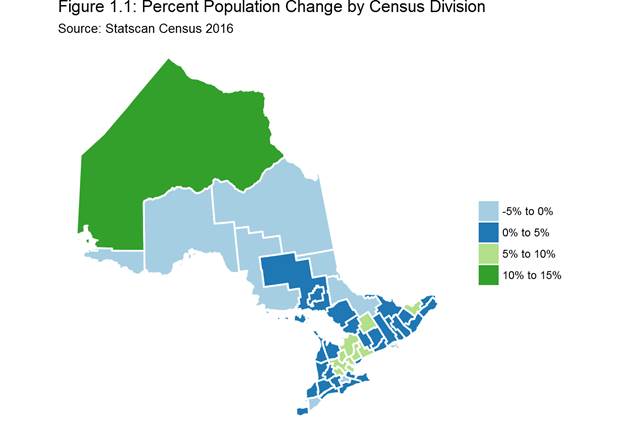
Figure 1.1 shows percentage change by
Census division. Unlike the following tables and graphs, this data also
includes unincorporated territories. While much of southern and eastern Ontario
are showing growth in the 0 to 5% range, the areas around the City of Toronto
are growing in the 5 - 10% range, while the City itself is in the 0 to 5 %
growth range along with much of the rest of Southern Eastern and South Western
Ontario, with a few exceptions for higher growth and a couple of districts
(Chatham-Kent, Brant, and Prince Edward County) showing some population
decline.
Much of North Eastern Ontario is showing
slight decline with the notable exception around the Sudbury region. It should
be noted that while the population in these areas are largely declining, we
will show evidence later that approximately half of the municipalities are
stable or showing growth.
North Western Ontario is showing a mix of
rapid growth in the Kenora census division and slight decline in the Rainy
River and Thunder Bay districts.
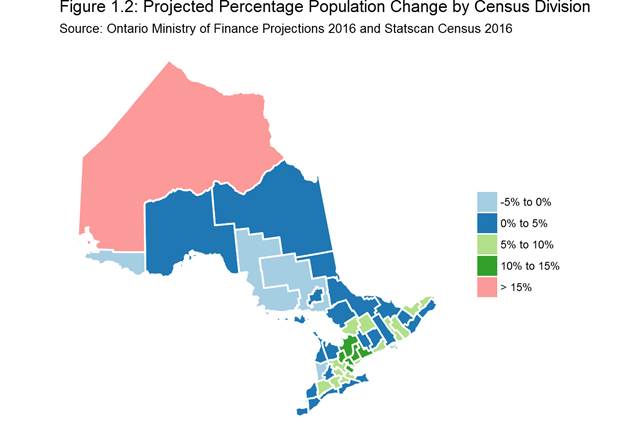
Figure 1.2 shows the expected changes in
Ontario based on the Ontario Ministry of Finance's population
projections for 2016. You will note that growth in many of the census
divisions is slightly less than expected, particularly in the areas around
Toronto and the North East.
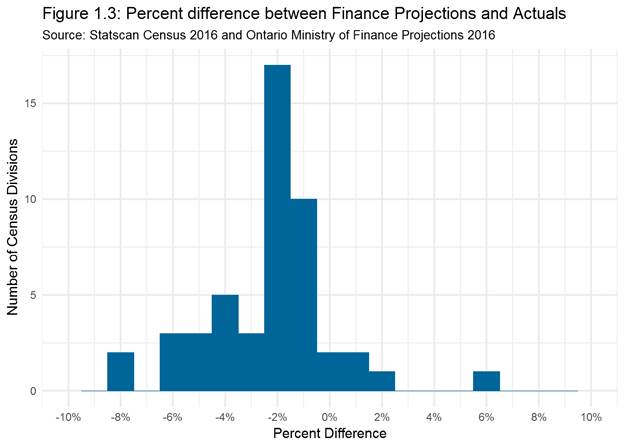
Figure 1.3 shows a histogram of the
percentage difference between projected population and the 2016 census
populations. Most census divisions have a lower population than projected in
the Spring of 2016, with two census divisions coming in at approximately 8%
lower than projected.
The Municipal Picture
Overall municipalities in Ontario are
growing. The median population in Ontario municipalities rose from 6,808 in
2011 to 7,081 in 2016, meaning 50% of municipalities in Ontario have a
population of at least 7,081. Meanwhile the average population rose from 45,895
to 48,114 in 2016, but as we will see a large part of that can be attributed to
growth in the large urbans. In terms of percentage of population change, the
average was 2.074% and the median was 2.032%. The biggest positive population
shift was 39% while the largest decline was 44.99%. See table 1.1, below, for
more details.
Table
1.1: Summary Statistics on Municipal Population Data
|
|
Population 2016
|
Population 2011
|
Percent Population Change
|
|
|
Min. : 0
|
Min. : 0
|
Min. :-44.988
|
|
|
1st Qu.: 1747
|
1st Qu.: 1808
|
1st Qu.: -1.182
|
|
|
Median : 7081
|
Median : 6808
|
Median : 2.032
|
|
|
Mean : 48144
|
Mean : 45895
|
Mean : 2.074
|
|
|
3rd Qu.: 20457
|
3rd Qu.: 18653
|
3rd Qu.: 5.107
|
|
|
Max. :2731571
|
Max. :2615060
|
Max. : 39.001
|
Figure 1.4 below shows that bulk of
municipalities are relatively stable in terms of population change. As noted in
table 1.1, the mean change in population is 2.074%, and most fall within the
-5% to 5% range and municipalities growing or declining at a rate of more than
10% are few.
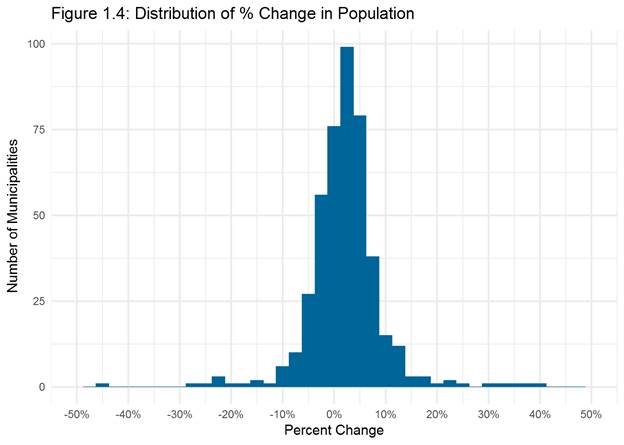
Municipalities by
MSO Region
When looking at municipalities in the
MSO regions we'll not that the largest growth region was the Central region
with 6.7% average growth and a median change of +4.78%. Municipalities in the
North Western region saw the most decline with an average of -2.82% and a
median change of -2.12%. See Table 1.2 to see the aggregate changes for
municipalities in your region.
Table
1.2: Percentage Change in Population in Ontario Municipalities (by MSO Region)
|
MSO Region
|
Number
of Municipalities
|
Average
% Change
|
Median
% Change
|
Min %
Change
|
Max %
Change
|
|
Central
|
78
|
6.70
|
4.78
|
-8.89
|
39.00
|
|
Eastern
|
114
|
1.59
|
1.50
|
-9.35
|
9.77
|
|
North Eastern
|
110
|
0.41
|
-0.01
|
-44.99
|
34.85
|
|
North Western
|
34
|
-2.82
|
-2.12
|
-22.30
|
12.15
|
|
Western
|
108
|
2.48
|
2.16
|
-7.95
|
37.43
|
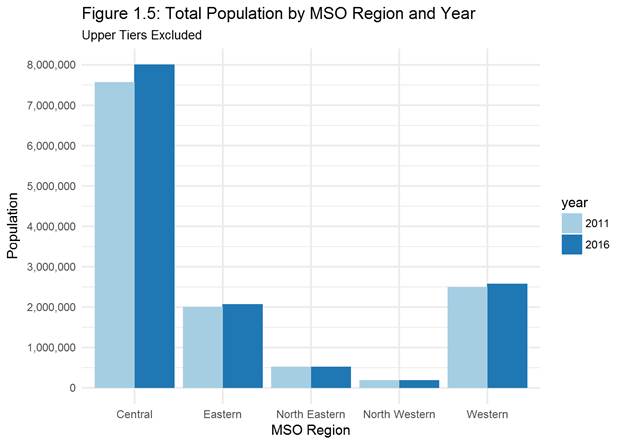
As shown in figure 1.5, above, the bulk
of Ontario's population lives in the Central region. Municipalities in that
region are also showing the most overall growth compared to 2011.
Municipalities
by Population Group
When comparing municipalities it can
be useful to group those that fall within a similar range of a particular
attribute to note differences within the spectrum. In this instance we have
divided Ontario's municipalities into 10 subgroups based on their population
range.
Table 1.3, shows that, for the most part,
smaller municipalities are getting smaller and large urbans are getting bigger.
Municipalities that fall in the 20 to 50K, 200 to 500K, and the great than 500K
ranges are experiencing the most growth, each with an average of above 5%.
Table
1.3: Percent Change in Population in Ontario Municipalities (by Population
Group)
|
Population Group
|
Number
of Municipalities
|
Average
% Change
|
Median
% Change
|
Min %
Change
|
Max %
Change
|
|
<1K
|
80
|
-0.36
|
-0.25
|
-44.99
|
37.43
|
|
1 - 2.5K
|
51
|
-0.40
|
-0.44
|
-14.14
|
11.81
|
|
2.5 - 5K
|
61
|
0.62
|
-0.11
|
-12.06
|
15.63
|
|
5 - 10K
|
75
|
2.35
|
1.59
|
-6.03
|
39.00
|
|
10 - 20K
|
65
|
3.32
|
3.08
|
-5.35
|
13.71
|
|
20 - 50K
|
42
|
5.55
|
3.76
|
-3.19
|
25.81
|
|
50 - 100K
|
26
|
3.40
|
3.36
|
-3.91
|
11.84
|
|
100 - 200K
|
24
|
4.24
|
2.48
|
-1.95
|
30.54
|
|
200K - 500K
|
10
|
5.41
|
5.52
|
2.62
|
9.03
|
|
>500K
|
10
|
6.30
|
5.98
|
1.14
|
13.31
|
Figure 1.6 shows how many people live in
municipalities of different sizes. When compared to table 1.3's 'Number of
Municipalities' counts it is clear that while there are substantively more
smaller municipalities their collective population pales in comparison to the
larger urban municipalities.
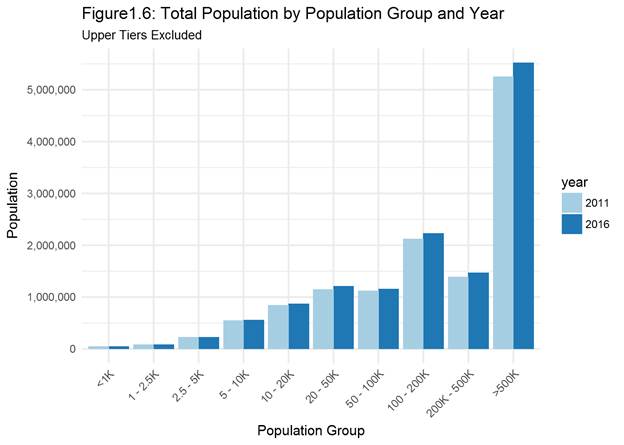
Conclusions
Some of the observations yielded
through cursory analysis are:
•
Ontario is growing but at a slower rate than the
rest of Canada.
•
Most of Ontario's population lives within
municipal boundaries; however, population growth in unincorporated territories
slightly outpaced that of municipalities, relatively speaking.
•
Ontario's population change is lower than
projections for most census divisions.
•
Most of Ontario's municipalities experienced
slight decline or slight growth (-5% to +5%), but there were a few outliers
with over 10% decline or growth on either side of the spectrum.
•
On aggregate, municipalities in the Central MSO
region are growing at a faster pace, while municipalities in the North West MSO
region are showing some decline.
•
On aggregate, smaller municipalities are getting
smaller or are stagnant and the larger urban municipalities are showing more
rapid growth.
Municipalities should note changes in
their census data, particularly their position relative to other municipalities
in Ontario. They will impact your municipality's ability to generate own source
revenue in the future, and they should impact your plans for future
infrastructure spending.
Census data will also factor into formula-based
funding, as is case with the aforementioned Federal Gas Tax. Population,
households, and median household income, in particular, often factor into
formula-based funding allocations, such as the Ontario Communities
Infrastructure Fund (OCIF) and several programs under the Ontario Municipal
Partnership Fund (OMPF).
Data Sources
•
A financial information return (FIR) compatible
datafile with 2016 Census data for all 444 Ontario municipalities is now
available in MFOA's Virtual Library
in CSV format. The datafile is compatible with FIR data in that it shares a
common municipal ID code attribute (MUNID). It can be found under 'Data Files.'
•
The maps were created using 2016 census boundary
files, which can be found on the Statistics
Canada website.
•
Municipal Service Office (MSO) regions were
determined using the Ministry of Municipal Affairs Financial Information Return
dataset for the year 2009 - the Current Year, available in CSV and RDA formats
on the FIR
website.
•
The Ontario Ministry of Finance population
projections uses the 2016 projections for census divisions from their annual
population projections, from 2016 to 2041. The data can be found in XLSX format
in the Province of Ontario's data catalogue.